1, Experimental purpose
1. Understand and master the assembly source program of more than 8086 logic segments
2. Understand and skillfully apply flexible addressing methods
3. Understand the essence of loop in programming language through the use of assembly instruction loop, and master its correct use in nested loop
4. Master the method of debugging 8086 assembler with debug
2, Experimental preparation
Review textbook chapters 5-8: assembly source program structure including multiple logic segments, addressing mode, assembly instruction loop, div usage
3, Experimental content
1
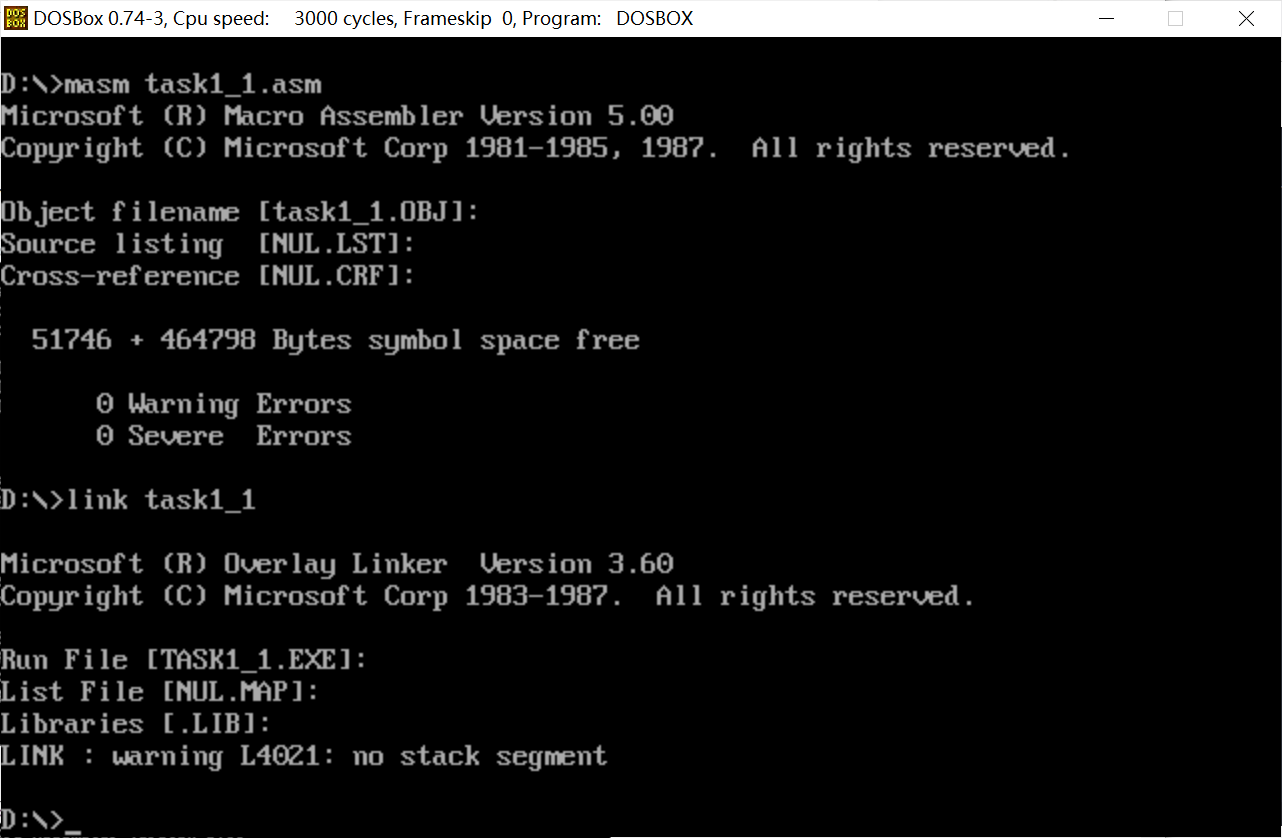
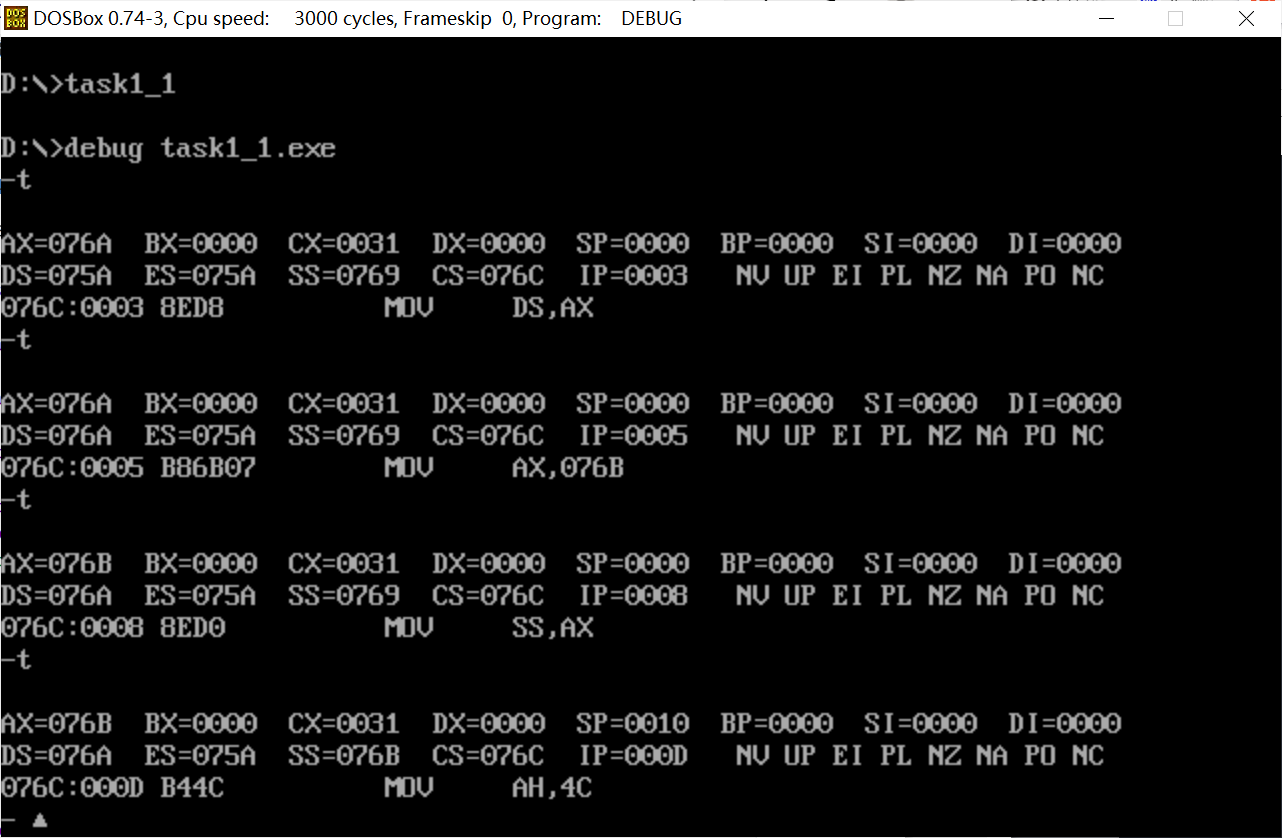
(1) In debug, execute until the end of line17 and before line19. Record this time: register (DS) =_ 076A___, Register (SS) =_ 076B___, Register (CS) =__ 076C__
(2) assuming that the segment address of the code segment is X after the program is loaded, the segment address of the data segment is _X-2 and the segment address of the stack is _X-1.
2.
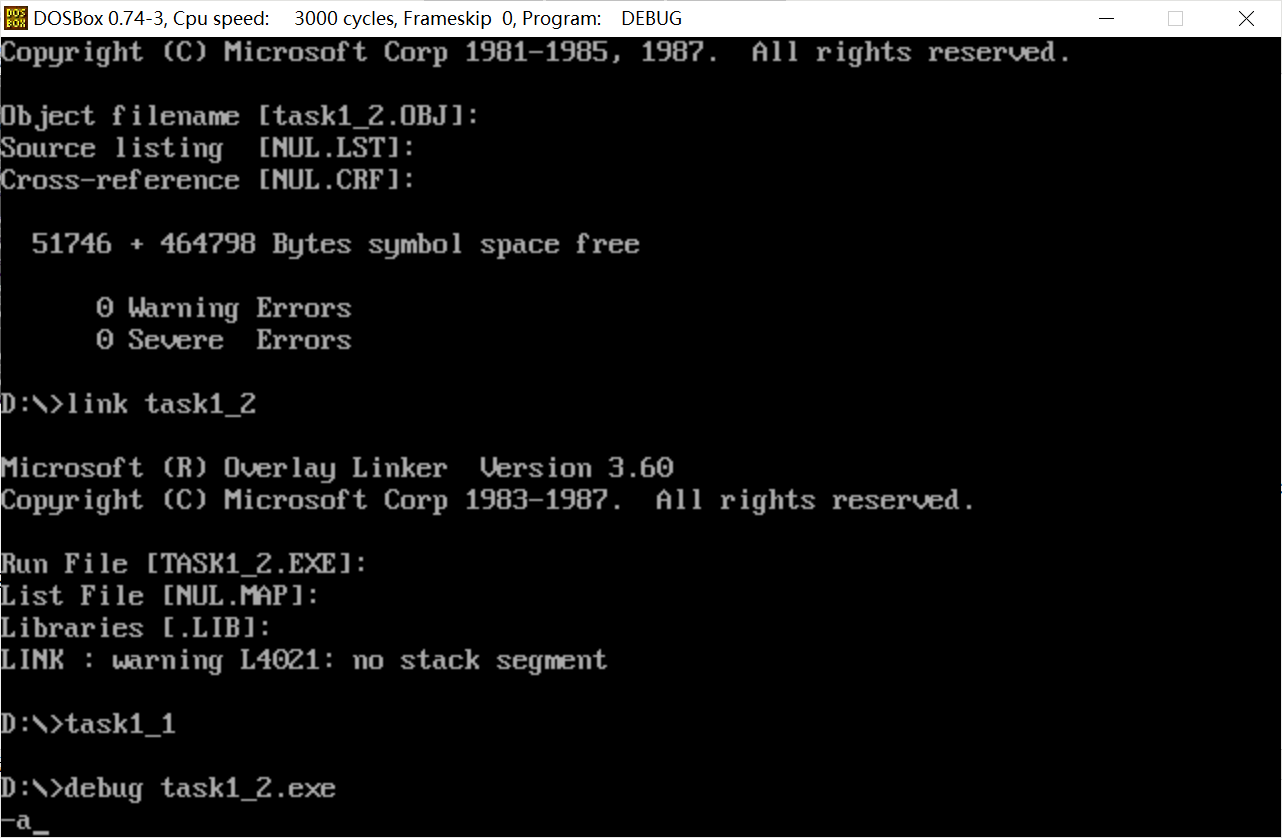
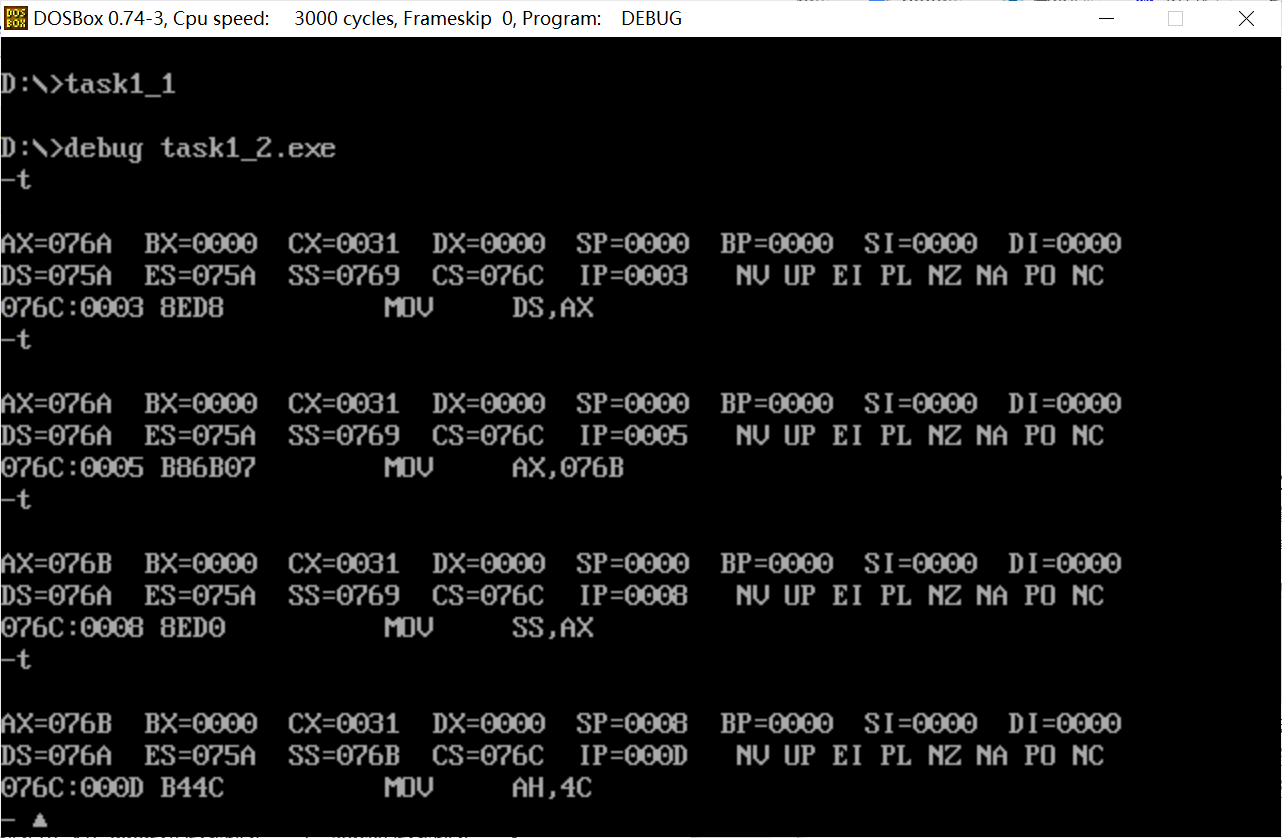
① In debug, execute until the end of line17 and before line19. Record this time: register (DS) = _076A, register (SS) = 076b, register (CS) = 076c__
② Assuming that the segment address of the code segment is X after the program is loaded, the segment address of the data segment is _X-2 and the segment address of the stack is _X-1.
3.
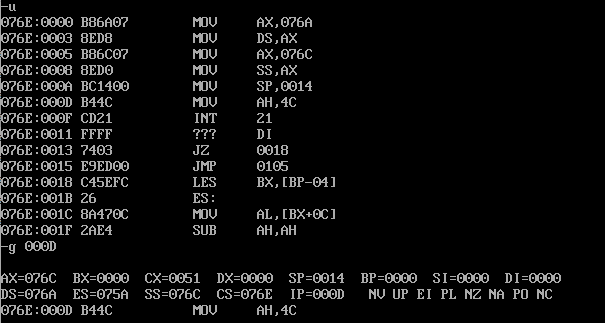
① In debug, it will be executed until the end of line17 and before line19. At this time, record: register (DS) = _076a_, register (SS) = 076c_, register (CS) = 076e_.
② Assuming that the segment address of the code segment is X after the program is loaded, the segment address of the data segment is _X-4 and the segment address of the stack is _X-2.
4.
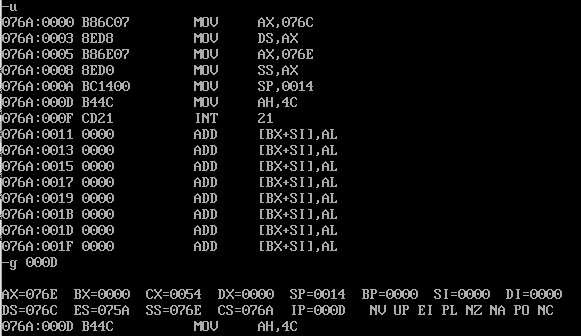
① In debug, execute until the end of line9 and before line11. Record this time: register (DS) = _ 076c _, register (SS) = _ 076e, register (CS) = _ 076a.
② Assuming that the segment address of the code segment is X after the program is loaded, the segment address of the data segment is _X+2 and the segment address of the stack is _X+4.
5.
① For the segment defined below, after the program is loaded, the actual memory space allocated to the segment is _2*[N/16] B ([] is rounded up).
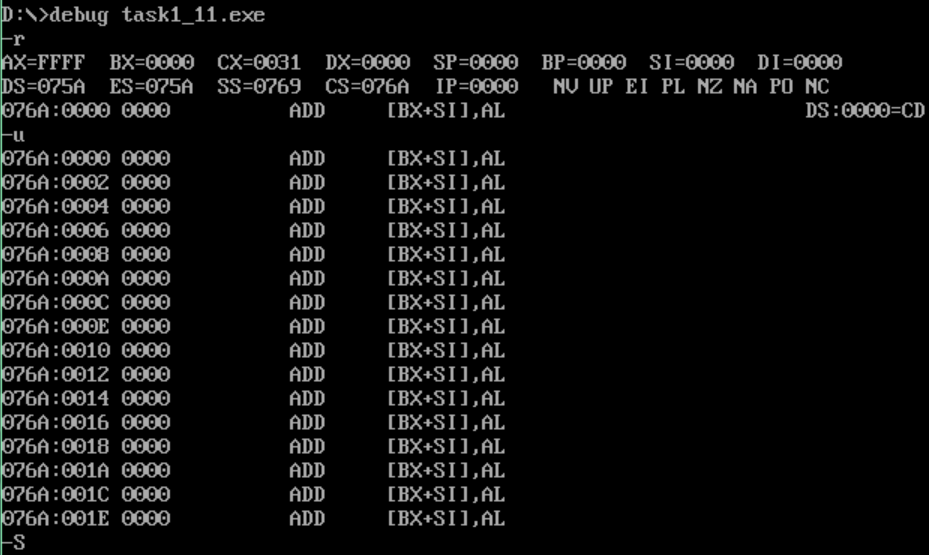
Program task1_4 can still be executed correctly. When start is not used to indicate the program entry, the program will read from the first line of code by default.
two
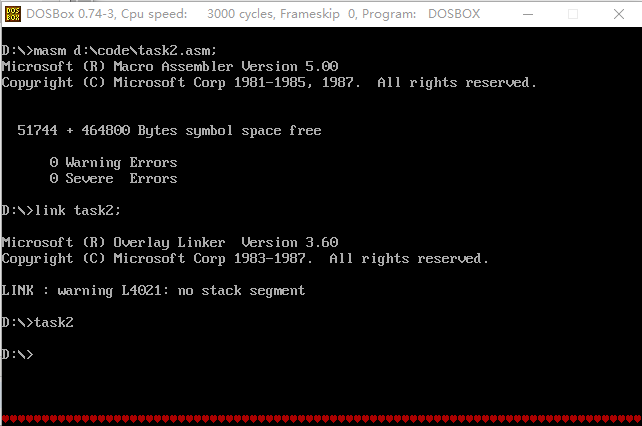
Three,
assume cs:code
data1 segment
db 50, 48, 50, 50, 0, 48, 49, 0, 48, 49 ; ten numbers
data1 ends
data2 segment
db 0, 0, 0, 0, 47, 0, 0, 47, 0, 0 ; ten numbers
data2 ends
data3 segment
db 16 dup(0)
data3 ends
code segment
start:
mov cx, 0ah
mov ax, data1
mov ds, ax
mov bx, 0
s: mov dl, [bx]
add dl, [16+bx]
mov [32+bx], dl
inc bx
loop s
mov ah, 4ch
int 21h
code ends
end start
Disassembly:
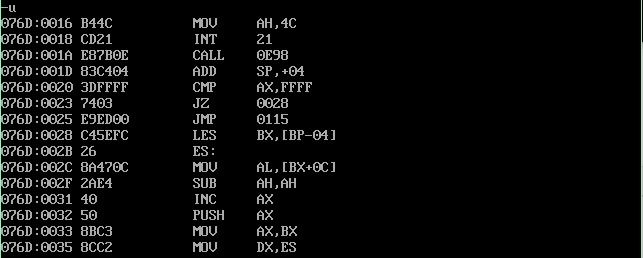
Before adding:

After addition:

Four,
assume cs:code
data1 segment
dw 2, 0, 4, 9, 2, 0, 1, 9
data1 ends
data2 segment
dw 8 dup(?)
data2 ends
code segment
start:
mov bx, 0
mov ax, data1
mov ds, ax
mov cx, 8
s1:
push [bx]
add bx, 2
loop s1
mov bx, 0
mov cx, 8
s2:
pop [bx+16]
add bx, 2
loop s2
mov ah, 4ch
int 21h
code ends
end start
Disassembly:
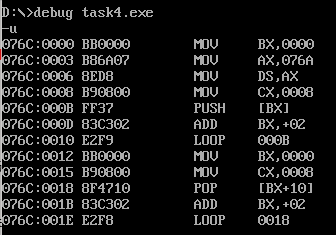
Before loading:

Five,
assume cs:code, ds:data
data segment
db 'Nuist'
db 2, 3, 4, 5, 6
data ends
code segment
start:
mov ax, data
mov ds, ax
mov ax, 0b800H
mov es, ax
mov cx, 5
mov si, 0
mov di, 0f00h
s: mov al, [si]
and al, 0dfh
mov es:[di], al
mov al, [5+si]
mov es:[di+1], al
inc si
add di, 2
loop s
mov ah, 4ch
int 21h
code ends
end start
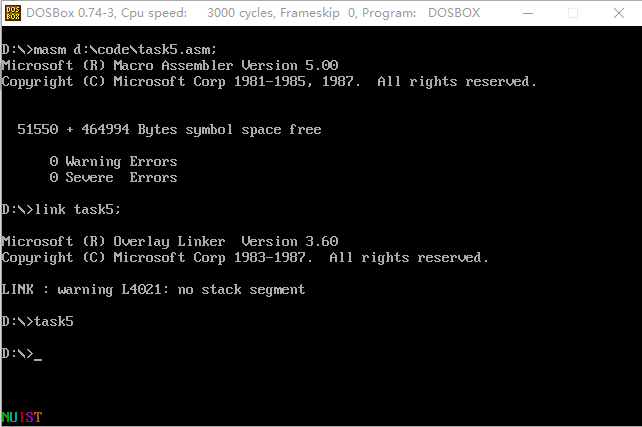
The g command is executed once before the program returns
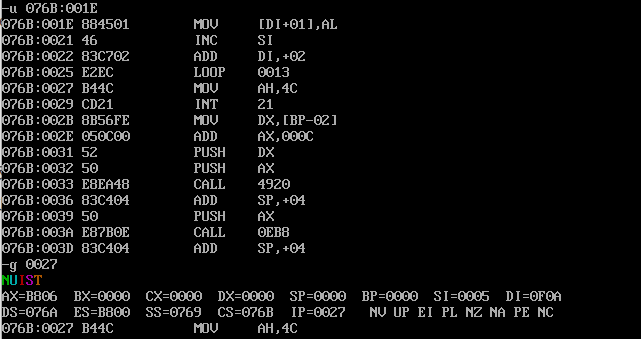
The function of line19 in the source code is: Convert lowercase letters to uppercase letters
In the source code, DB 2,3,4,5,6 -- > is changed to: db 5 dup(2)
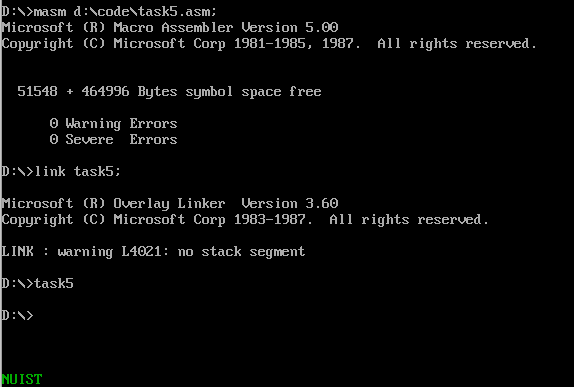
The purpose of the byte data of line4 in the data section of the source code is: the function of line4 is to set the color
six
assume cs:code, ds:data, ss:stack
data segment
db 'Pink Floyd '
db 'JOAN Baez '
db 'NEIL Young '
db 'Joan Lennon '
data ends
stack segment
dw 1 dup(?)
stack ends
code segment
start:
mov ax,stack
mov ss,ax
mov sp,1
mov ax,data
mov ds,ax
mov ax,data
mov es,ax
mov cx,4
s:
push cx
mov bx,0
mov cx,4
s2:
mov al,es:[bx]
or al,20h
mov es:[bx],al
inc bx
loop s2
pop cx
mov ax,es
inc ax
mov es,ax
loop s
mov ah, 4ch
int 21h
code ends
end start
load:
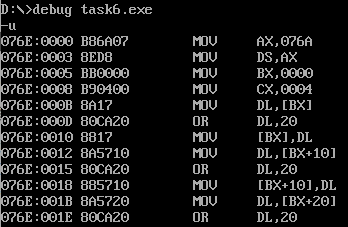
Disassembly:
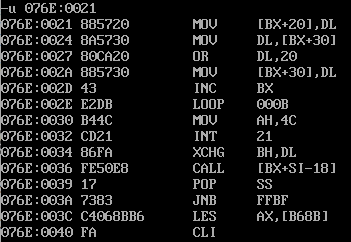
result:

Seven,
assume cs:code, ds:data, es:table,ss:stack
data segment
db '1975', '1976', '1977', '1978', '1979'
dd 16, 22, 382, 1356, 2390
dw 3, 7, 9, 13, 28
data ends
table segment
db 5 dup( 16 dup(' ') ) ;
table ends
stack segment
dw 1 dup(?)
stack ends
code segment
start:
mov ax,stack
mov ss,ax
mov sp,1
mov ax,data
mov ds,ax
mov ax,table
mov es,ax
mov di,0;data
;1
mov bx,0;table
mov si,0;table
mov cx,5
year:
push cx
mov cx,4
year2:
mov al,ds:[di]
mov es:[bx+si],al
inc si
inc di
loop year2
pop cx
add bx,10h
mov si,0
loop year
;2
mov bx,0
mov si,5
mov cx,5
income:
push cx
mov cx,4
income2:
mov al,ds:[di]
mov es:[bx+si],al
inc si
inc di
loop income2
pop cx
add bx,10h
mov si,5
loop income
;3
mov bx,0
mov si,10
mov cx,5
num:
push cx
mov cx,2
num2:
mov al,ds:[di]
mov es:[bx+si],al
inc si
inc di
loop num2
pop cx
add bx,10h
mov si,10
loop num
;4
mov bx,0
mov si,5
mov cx,5
cal:
mov ax,word ptr es:[bx+si]
add si,2
mov dx,word ptr es:[bx+si]
add si,3
div word ptr es:[bx+si]
add si,3
mov word ptr es:[bx+si],ax
add bx,10h
mov si,5
loop cal
mov ah, 4ch
int 21h
code ends
end start
Commissioning screenshot:
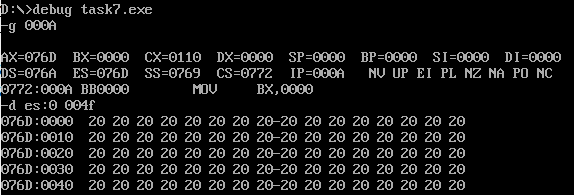
Run in debug until the program exits, use the d command to view the screenshot of the memory space corresponding to the table segment, and confirm whether the information is structurally written to the specified memory as required
